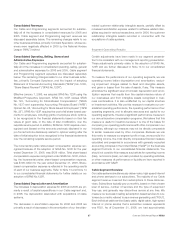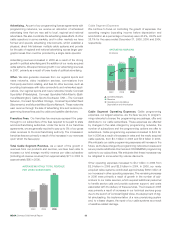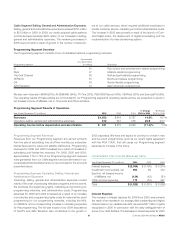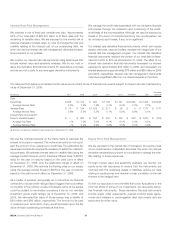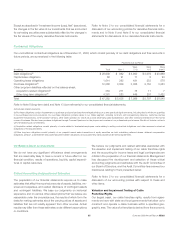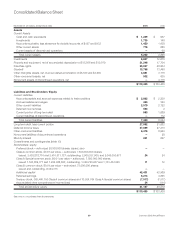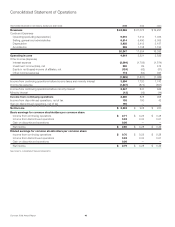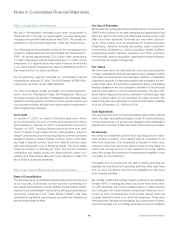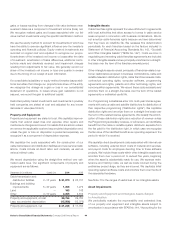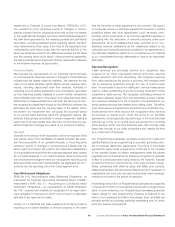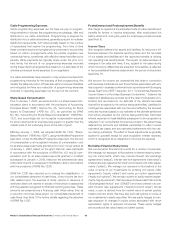Comcast 2006 Annual Report Download - page 38
Download and view the complete annual report
Please find page 38 of the 2006 Comcast annual report below. You can navigate through the pages in the report by either clicking on the pages listed below, or by using the keyword search tool below to find specific information within the annual report.MD&A Comcast 2006 Annual Report 36
benefits we receive from the right to solicit new subscribers and to
market new services such as additional digital cable services, high-
speed Internet and phone services in a particular service area. The
amounts we record for cable franchise rights are primarily the result
of cable system acquisitions. Typically when we acquire a cable
system, the most significant asset we record is the value of the
franchise intangible. Often these cable system acquisitions include
multiple franchise areas. We currently serve approximately 6,000
franchise areas in the United States.
We have concluded that our cable franchise rights have an indefi-
nite useful life since there are no legal, regulatory, contractual,
competitive, economic or other factors which limit the period over
which these rights will contribute to our cash flows. Accordingly,
we do not amortize our cable franchise rights but assess the carry-
ing value of our cable franchise rights annually, or more frequently
whenever events or changes in circumstances indicate that the
carrying amount may exceed its fair value (the “impairment test”)
in accordance with SFAS No. 142, “Goodwill and Other Intangible
Assets.”
If we determine the value of our cable franchise rights is less than
the carrying amount, we recognize an impairment charge for the
difference between the estimated fair value and the carrying value
of the assets. For the purpose of our impairment testing, we have
grouped the recorded values of our various cable franchise rights
into geographic regions. We evaluate these groups periodically to
ensure impairment testing is performed at an appropriate level.
We estimate the fair value of our cable franchise rights primarily
based on a discounted cash flow analysis that involves significant
judgment in developing individual assumptions for each of the geo-
graphic regions, including long-term growth rate and discount rate
assumptions. We have not recorded any significant impairment
charges as a result of our impairment testing.
We could record impairment charges in the future if there are
changes in market conditions, operating results, federal or state
regulations, or groupings of the geographic regions in which we
test for impairment, in any such case that prevent us from recover-
ing the carrying value of these cable franchise rights. At our last
impairment test date, the amounts by which the estimated fair
value of our cable franchise rights exceeded the carrying value for
our geographic regions ranged from zero to in excess of $2.0 bil-
lion. A 10% decline in the estimated fair value of the cable franchise
rights for each of these regions would result in an impairment in
three of these regions and an impairment charge of approximately
$540 million.
Income Taxes
Our provision for income taxes is based on our current period
income, changes in deferred income tax assets and liabilities,
income tax rates and tax planning opportunities available in the
jurisdictions in which we operate. From time to time, we engage
in transactions in which the tax consequences may be subject
to uncertainty. Examples of such transactions include business
acquisitions and disposals, including like-kind exchanges of
cable systems, issues related to consideration paid or received
in connection with acquisitions, and certain financing transac-
tions. Significant judgment is required in assessing and estimating
the tax consequences of these transactions. We prepare and file
tax returns based on our interpretation of tax laws and regula-
tions, and we record estimates based on these judgments and
interpretations.
In the normal course of business, our tax returns are subject to
examination by various taxing authorities. Such examinations may
result in future tax and interest assessments by these taxing author-
ities. We adjust our estimates periodically because of ongoing
examinations by and settlements with the various taxing authori-
ties, as well as changes in tax laws, regulations and precedent.
The effects on our financial statements of income tax uncertain-
ties that arise in connection with business combinations and those
associated with entities acquired in business combinations are
discussed in Note 2 to our consolidated financial statements. The
consolidated tax provision of any given year includes adjustments
to prior year income tax accruals that are considered appropri-
ate and any related estimated interest. We believe that adequate
accruals have been made for income taxes. Differences between
the estimated and actual amounts determined upon ultimate reso-
lution, individually or in the aggregate, are not expected to have a
material adverse effect on our consolidated financial position, but
could possibly be material to our consolidated results of operations
or cash flow of any one period.
Legal Contingencies
We are subject to legal, regulatory and other proceedings and
claims that arise in the ordinary course of our business and, in
certain cases, those that we assume from an acquired entity in a
business combination. We record an estimated liability for those
proceedings and claims arising in the ordinary course of business
based upon the probable and reasonably estimable criteria con-
tained in SFAS No. 5, “Accounting for Contingencies.” For those
litigation contingencies assumed in a business combination, we
record a liability based on estimated fair value when we can deter-
mine such fair value. We review outstanding claims with internal as
well as external counsel to assess the probability and the estimates
of loss. We reassess the risk of loss as new information becomes
available, and we adjust liabilities as appropriate. The actual cost
of resolving a claim may be substantially different from the amount
of the liability recorded. Differences between the estimated and
actual amounts determined upon ultimate resolution, individually
or in the aggregate, are not expected to have a material adverse
effect on our consolidated financial position, but could possibly be
material to our consolidated results of operations or cash flow of
any one period.



